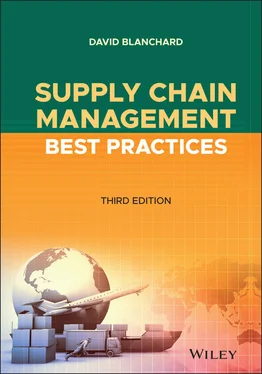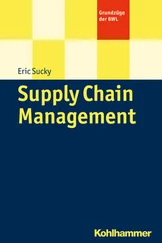Using the invoice exercise as a starting point, Bolstorff notes, Imation's supply chain team modeled a material flow strategy that would accommodate customer needs while supporting the company's competitive requirements. This type of exercise was also used to model (1) product flow, which focused on postponement—delaying final customization of a product until the last possible moment—as a key best practice; (2) system utilization, which overhauled Imation's overly complex pricing practices; and (3) a collaborative planning, forecasting, and replenishment (CPFR) initiative, which aimed at improving return on investment by working more closely with Imation's retail customers to effectively manage inventory.
“The SCOR project roadmap,” Bolstorff explains, “can be effectively used at multiple performance levels: eliminating deficiencies, establishing a continuous improvement process, and defining strategic supply chain investments to support competitive advantage.” 19
Whether your company adopts the SCOR model or chooses a less structured approach to tracking its supply chain, at some point you're going to have to put all that data you've been gathering into context, and that might prove to be even more difficult than setting up the metrics in the first place. “The toughest part of establishing measures is making them meaningful in the right way,” admit consultants Mike Ledyard and Kate Vitasek, faculty members of the University of Tennessee's Vested program. Even if you have an elaborate system of scorecards that measures every group within your company's supply chain, it'll just be an empty show of sound and fury if you can't link the performance measures to actionable plans linked to specific company goals. “Measures must be aligned to strategy,” they note, “but it's important that the measurements be linked to logistics execution. Without that vital link and ample communication, the people performing the logistics tasks in your organization won't see the value or the connection between what they do and the larger corporate or division strategy.”
According to Ledyard and Vitasek, before getting too caught up in measurements and metrics, every supply chain professional needs to answer two key questions:
1 Will you change your behavior, or ask others to change their behavior, based on this measure?
2 Does the potential benefit gained from this information exceed the cost of obtaining it?
Citing advice from the late management guru Peter Drucker, Ledyard and Vitasek observe, “There is surely nothing quite so useless as doing with great efficiency what should not be done at all.” And that, they say, sums up the wasted effort of the measurement trap—merely collecting measures for collection's sake, without a clear plan as to how you plan to meet your company's overall objectives and goals. 20
It's better by far to follow a path similar to that trod by high-tech giant IBM. To evaluate the performance of its suppliers, IBM devised a detailed scorecard that tracks how each supplier is performing and how well they deliver to Big Blue's requirements. IBM would routinely review scorecards with suppliers, including transportation providers, to identify where improvements might be needed. If those improvements didn't happen, then IBM would use the scorecard itself as justification for no longer considering that supplier a vendor of choice. Such an approach eliminates any ambiguity as it was quite clear to all parties involved what the expectations were. 21
Returning to our opening observation about baseball statistics, just as sabermetricians appear to have an endless appetite for creating even more ways to measure a player's performance (why be content with charting a player's batting average when you can also chart things like his batting average on balls in play and weighted runs above average?), so too are supply chain professionals never really satisfied with using the same set of metrics from year to year. For instance, the Warehousing Education and Research Council (WERC) conducts an annual study examining which metrics are most frequently used to measure operational performance in warehouses and distribution centers (DCs), and that list can be quite fluid.
In the DC Measures study for 2019 (which highlights that year's 12 most popular metrics), several metrics appeared in the top 12 that were far down the list the previous year. The “number of orders shipped complete per customer order” appeared at number 2 in 2019, whereas it had been at number 34 in 2018. Similarly, the “percent of orders with on-time delivery” metric was the number-4 choice in 2019, but the number-33 choice in 2018. Both of those metrics, according to WERC, are customer-facing metrics and are used to measure a company's performance at achieving perfect orders. In the previous 16 years of the DC Measures study, “perfect order” metrics had never appeared in the Top 12, illustrating a shift in focus toward operations and away from employees. As the study notes, metrics focused on supply chain talent tend to rise or fall in relative importance based on the state of the economy and the availability—or lack thereof—of employees in key areas, like warehousing. 22
“The appropriate metrics to manage and measure the success of a company's operation vary significantly by industry, by individual company, and by the scale of the business,” observes Tan Miller, director of Rider University's Global Supply Chain Management Program. “What does not vary, however, is the universal need of all companies to employ a well-structured, hierarchical framework to organize and manage their metrics.” 23
As Miller explains, a hierarchical supply chain performance measurement framework (HPMF) has three levels: strategic, tactical, and operational. “In an HPMF, it is the scale of an operation or activity that a particular metric monitors which determines its place in the hierarchy. Metrics that measure the performance of an entire major functional area, such as distribution, are considered strategic, while metrics that monitor major subfunctions, such as warehouse operations and transportation, are categorized as tactical. And finally, metrics that monitor subfunctions of subfunctions, such as the receiving operation in a warehouse, are considered operational.” The goal of such a framework, Miller says, is to align all of a company's supply chain activities to achieve a desired mission and objective.
As the WERC study illustrates, companies' objectives can shift significantly as market conditions themselves shift—for instance, as customers demand shipments in smaller lots but delivered more quickly than before, companies have to adapt by improving their perfect order metrics, which concurrently means placing less emphasis on other metrics (such as workforce measurements). In any event, the better a company understands its capabilities—and can frame those capabilities into a meaningful context—the better it can measure its performance in the areas that are most important to its customers.
1 1John Thorn, “Sabermetrics,” Total Baseball, 3rd ed. (New York: HarperPerennial, 1993), 620.
2 2Jaewon Kang, “Coty Stumbles Amid Supply-Chain Disruptions,” Wall Street Journal (7 November 2018), www.wsj.com.
3 3Kim Bhasin, “Coty CEO Frustrated with Supply Chain Snags at Beauty Brands,” Bloomberg (7 November 2018), www.bloomberg.com.
4 4David Blanchard, “Chain Reactions,” Logistics Today (March 2004), 6.
5 5Reuben E. Sloane, J. Paul Dittmann, and John T. Mentzer, The New Supply Chain Agenda (Boston: Harvard Business Press, 2010), 4–5.
6 6David Blanchard, “Moving Past the Problems Can Be Problematical,” Chief Logistics Officer (October 2003), 5.
Читать дальше












